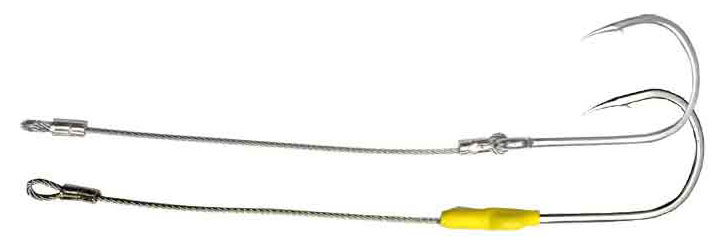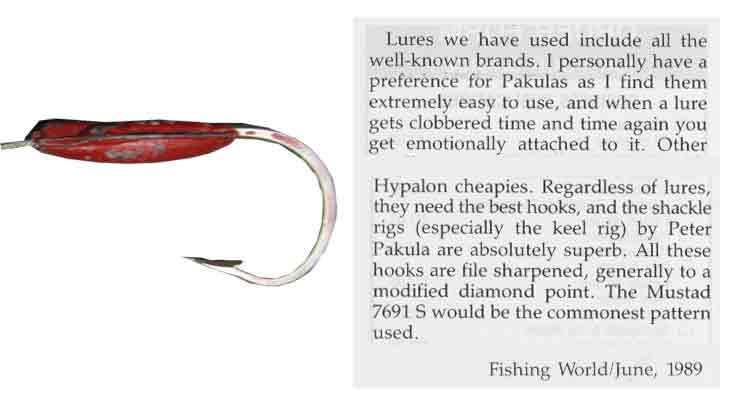THE PAKULA SWIVEL RIG
by Peter Pakula 26TH April 2025

THE JOURNEY
Every design goes through a journey of trying to solve perceived problems. Pakula Lures are designed to attract fish from far away using UV, Lumo, and CAT colours and additives. Head shapes are designed to have maximum vibration through head shapes and various jet configurations to create the loudest sonics ie vibrations. Most Pakula lures have a violent head shake.
STIFF RIGS
Previous to the Pakula Rigs the most common rigs in both single and twin hook rigs were stiff rigs.
The Stiff Rigs, also known as semi stiff rigs, are still in common use. They have wire or nylon tight on the hook eye.
When it comes to using them with Pakula lures there is a major problem. Because of the major vibration of Pakula Lures the wire fatigues and breaks. This is often blamed on ‘Toothy Critters’ and took a long time to understand it was the action of the lure head that caused the wire to fatigue and break. The Pakula Semi Satellite lure, the Beer Barrels’ big brother, would ‘spit’ the hooks in around 20 minutes!!
The other disadvantage was that the stiff rig would restrict the action of Pakula Lures. I often referred to this as “strapping a broomstick to a ballerina’s back and expecting her to dance.”
THE SIXTY DEGREE SHACKLE RIG

The first part of our journey was the Shackle Rig which without question has the highest success rate of any twin hook rig and was the preferred rig for many years. They were called the “Talons of Death” by Hawaiian journalist Jim Rizzuto.
The Shackle Rigs were very dangerous for fish and anglers alike especially if you wanted to release fish which became more the norm.
So it was time to come up with a safer alternative.
THE ORIGINAL PAKULA KEEL RIG 1989

The Keel Rig was incredibly successful. It was a modified version of the Shackle Rig and was also a twin hook rig. It was just impractical to make enough rigs in our small business.

It was our original Keel Rig that inspired the first Single Hook Keel Rigs.
The Keel weights were bound to the underside of the hook. Once again incredibly successful. It was found that when anglers lost the weights and didn’t have any to replace them the rig performed as well, so they didn’t need the weights.
THE SWIVEL RIG 2010

The outcome of the journey is the Pakula Swivel rig.
The parts and reason for the setup is as follows:
1: The Swivel is of a greater braking strain than the leader. The Heat shrink goes over the wires’ crimp and halfway or fully over the eye of swivel to prevent it cocking up.
2: The wire is 7x7 316 Stainless steel of a breaking strain greater than the lure leader. (1.5mm for light gauge hooks and 2mm for heavy gauge hooks)
3: The heat shrink goes halfway over the wire loop to stop the hook cocking up on the wire as shown in the image below.
4: The heat shrink goes halfway over the hook’s eye once again to stop the hook from fouling on the wire’s loop. The heat shrink continues down the shank of the hook for three reasons:
A: The colour is yellow because the tail of most baitfish is yellow and we position hooks so that just the eye of the hook is within the skirt.
B: The heat shrink is also for forensics. If the fish marks the hook on the sides, then the hook is not running upright. If the fish marks the heat shrink on the inside the bight and on the bottom then the hook was running correctly ie point up and there was another problem such as strike drag, too much drop back etc.
C: To reduce the magnetic field of the hook. Even though hooks may be stainless steel, for strength they do have a ferrous content. When a ferrous object travels over the earth’s surface it generates a magnetic field that many fish species can detect and reject.
5: The hook bend is the heaviest part of the hook. As the boat goes through choppy seas and swells the boat will accelerate and slow down in the seas. The swivel rig allows the rig to compensate by letting the hook rise and fall with the conditions. That is it pivots on the loop.
The Pakula Swivel Rig allows each part of the rig to adapt to the trolling conditions independent of the lure.
All lure heads are handmade and rarely symmetrical, and even if they are, such as 3D printed lure heads, the skirts are also handmade and rarely symmetrical as they have various layers of colours and additives. It’s rare for a lure to work as you’d expect. The Swivel rig compensates for all of the inconsistencies and offers a great success rate depending on the many other things that go into achieving a great hookup rate.




